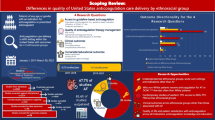Abstract
Background
Anticoagulation is a cornerstone in atrial fibrillation (AF) management for stroke prevention. Studies showed that oral anticoagulants (OAC), previously limited to warfarin, were underused. Recently, non-vitamin K oral anticoagulants (NOACs) have seen widespread adoption, but it has not been well studied whether there has been a subsequent increase in OAC usage in AF patients.
Methods
We quantified OAC rates in AF patients in a large multispecialty health system in the Northeast United States. A total of 351,795 patients seen in the network over the preceding 18 months were reviewed.
Results
Of these patients, 8727 (2.5%) carried a diagnosis of AF, and, of the 6933 patients with a CHA2DS2-VASc score of 2 or higher, 5576 (80.4%) had an OAC listed as an active medication or had received a left atrial appendage occlusion device. Of the 6605 patients treated with an OAC, 5308 (80.4%) were treated with a NOAC and 1295 (19.6%) were prescribed warfarin. A higher percentage of patients with CHA2DS2-VASc ≥ 2 who had seen a cardiologist were treated with an OAC vs. those who had not seen a cardiologist in the prior 18 months (83.95% vs. 67.43%, p < 0.01).
Conclusions
We show dramatically increased OAC usage among patients with AF and that NOACs comprise the large majority of OACs compared with previous studies. This suggests an association between widespread adoption of NOACs and increased oral anticoagulation rates. Future directions include assessing barriers to oral anticoagulation and developing interventions to reduce disparity in OAC use between clinics.



Similar content being viewed by others
References
Colilla S, Crow A, Petkun W, Singer DE, Simon T, Liu X. Estimates of current and future incidence and prevalence of atrial fibrillation in the U.S. adult population. Am J Cardiol. 2013;112(8):1142–7. https://doi.org/10.1016/j.amjcard.2013.05.063.
January CT, Wann LS, Calkins H, Chen LY, Cigarroa JE, Cleveland JC Jr, Ellinor PT, Ezekowitz MD, Field ME, Furie KL, Heidenreich PA, Murray KT, Shea JB, Tracy CM, Yancy CW. AHA/ACC/HRS focused update of the 2014 AHA/ACC/HRS guideline for the management of patients with atrial fibrillation: a report of the American College of Cardiology/American Heart Association Task Force on Clinical Practice Guidelines and the Heart Rhythm Society in Collaboration with the Society of Thoracic Surgeons. Circulation. 2019;140(2):e125–51. https://doi.org/10.1161/CIR.0000000000000665.
Heidenreich PA, Estes NAM 3rd, Fonarow GC, Jurgens CY, Kittleson MM, Marine JE, McManus DD, McNamara RL. 2020 Update to the 2016 ACC/AHA clinical performance and quality measures for adults with atrial fibrillation or atrial flutter: a report of the American College of Cardiology/American Heart Association Task Force on Performance Measures. J Am Coll Cardiol. 2021;77(3):326–41. https://doi.org/10.1016/j.jacc.2020.08.037.
Chan PS, Maddox TM, Tang F, Spinler S, Spertus JA. Practice-level variation in warfarin use among outpatients with atrial fibrillation (from the NCDR PINNACLE program). Am J Cardiol. 2011;108(8):1136–40. https://doi.org/10.1016/j.amjcard.2011.06.017.
Munir MB, Hlavacek P, Keshishian A, et al. Oral anticoagulant underutilization among elderly patients with atrial fibrillation: insights from the United States Medicare database [published online ahead of print, 2022 Jul 9]. J Interv Card Electrophysiol. 2022. https://doi.org/10.1007/s10840-022-01274-1.
Marzec LN, Wang J, Shah ND, Chan PS, Ting HH, Gosch KL, Hsu JC, Maddox TM. Influence of direct oral anticoagulants on rates of oral anticoagulation for atrial fibrillation. J Am Coll Cardiol. 2017;69(20):2475–84. https://doi.org/10.1016/j.jacc.2017.03.540.
Health insurance coverage of the total population, multiple sources of coverage. KFF. Published October 23, 2020. https://www.kff.org/other/state-indicator/health-insurance-coverage-of-the-total-population-multiple-sources-of-coverage/. Accessed 27 Dec 2021.
Kirchhof P, Camm AJ, Goette A, Brandes A, Eckardt L, Elvan A, Fetsch T, van Gelder IC, Haase D, Haegeli LM, Hamann F, Heidbüchel H, Hindricks G, Kautzner J, Kuck KH, Mont L, Ng GA, Rekosz J, Schoen N, Schotten U, Suling A, Taggeselle J, Themistoclakis S, Vettorazzi E, Vardas P, Wegscheider K, Willems S, Crijns HJGM, Breithardt G. EAST-AFNET 4 Trial Investigators. Early rhythm-control therapy in patients with atrial fibrillation. N Engl J Med. 2020;383(14):1305–1316. https://doi.org/10.1056/NEJMoa2019422.
Vinereanu D, Lopes RD, Bahit MC, et al. A multifaceted intervention to improve treatment with oral anticoagulants in atrial fibrillation (IMPACT-AF): an international, cluster-randomised trial. Lancet. 2017;390(10104):1737–46. https://doi.org/10.1016/S0140-6736(17)32165-7.
Maradey JA, Malaver D, Nielsen D, Herrington DM, Bhave P. Abstract 11412: Lower out-of-pocket costs are associated with higher NOAC persistence in atrial fibrillation. Circulation. 2019;140(1):A11412–A11412. https://doi.org/10.1161/circ.140.suppl_1.11412.
Naccarelli GV, Ruzieh M, Wolbrette DL, et al. Oral anticoagulation use in high-risk patients is improved by elimination of false-positive and inactive atrial fibrillation cases. Am J Med. 2021;134(6):e366–73. https://doi.org/10.1016/j.amjmed.2020.11.024.
Pokorney SD, Cocoros N, Al-Khalidi HR, et al. Effect of mailing educational material to patients with atrial fibrillation and their clinicians on use of oral anticoagulants: a randomized clinical trial. JAMA Netw Open. 2022;5(5):e2214321. https://doi.org/10.1001/jamanetworkopen.2022.14321.
Author information
Authors and Affiliations
Corresponding author
Ethics declarations
Ethics approval and consent to participate
This retrospective chart review study involving human participants was in accordance with the ethical standards of St. Elizabeth’s Medical Center Institutional Review Board (IRB) and with the 1964 Helsinki Declaration and its later amendments or comparable ethical standards. St. Elizabeth’s Medical Center’s IRB approved this study.
Consent for publication
Not applicable.
Conflict of interest
The authors declare no competing interests.
Additional information
Publisher's note
Springer Nature remains neutral with regard to jurisdictional claims in published maps and institutional affiliations.
Rights and permissions
Springer Nature or its licensor (e.g. a society or other partner) holds exclusive rights to this article under a publishing agreement with the author(s) or other rightsholder(s); author self-archiving of the accepted manuscript version of this article is solely governed by the terms of such publishing agreement and applicable law.
About this article
Cite this article
Dutta, R., Hurley, S., Atkins, D. et al. High rates of oral anticoagulation in atrial fibrillation patients observed in a large multi-specialty health system in the Northeast. J Interv Card Electrophysiol 66, 1119–1124 (2023). https://doi.org/10.1007/s10840-022-01395-7
Received:
Accepted:
Published:
Issue Date:
DOI: https://doi.org/10.1007/s10840-022-01395-7




